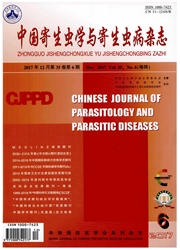

 中文摘要:
中文摘要:
目的RNA原位杂交法观察弓形虫速殖子黏附和侵入小肠黏膜的部位及时间。方法30只BALB/c小鼠随机分为两组,实验组(24只)每鼠灌胃感染2×10^4个弓形虫速殖子(悬于0.2ml PBS),对照组(6只)给予等量PBS。分别于感染后15min、30min、1h、2h、4h和8h各处死实验组小鼠4只和对照组小鼠1只,取十二指肠、空肠和回肠标本制备石蜡切片,并作RNA原位杂交。光学显微镜观察原位杂交切片,随机选取50个视野,计数所有观察视野内的虫体总数并计算平均数。结果侵入的弓形虫速殖子可位于小肠上皮细胞(吸收细胞、杯状细胞和内分泌细胞)的纹状缘、吸收细胞胞浆内或相邻吸收细胞间及固有层内。感染后15min,黏附于空肠的速殖子数量(4.93±3.949)显著高于回肠(3.78±3.102)(P〈0.05);侵入空肠的速殖子数量(4.92±4.164)显著高于十二指肠(4.10±3.532)和回肠(3.68±3.301)(P〈0.05)。随着感染后时间的延长.黏附于各肠段的速殖子数量逐渐减少,而侵入的数量逐渐增多。与感染后15min相比,感染后8h。黏附于十二指肠(2.32±3.039)、空肠(3.15±3.241)和回肠黏膜(2.59±3.028)的速殖子数量均显著减少(心0.05),而侵入十二指肠(8.92±8.955)、空肠(9.11±6.667)和回肠黏膜(9.15±10.192)的速殖子数量均显著增加(P〈0.05)。结论弓形虫速殖子对其所黏附的小肠上皮细胞无严格的选择性,但其侵入小肠的部位具有选择性,空肠为速殖子侵入的易感部位。
 英文摘要:
英文摘要:
Objective To observe dynamically the location and time of attachment and invasion of Toxoplasma gondii tachyzoites to murine intestinal mucosa by chromogenic in situ hybridization targeting SAG2 mRNA. Methods Thirty 7- to 8-week-old BALB/c mice were randomly divided into experiment group (24 mice) and control group (6 mice). Each animal in the experiment group was given 2×10^4 tachyzoites of RH stain in 0.2 ml PBS by intragastric administration and that in the control group was given 0.2 ml PBS. Four mice in the experiment group and one in the control group were sacrificed at 15 min, 30 min, 1 h, 2 h, 4 h and 8 h after infection, respectively, and paraffin sections of duodenum, jejunum and ileum were prepared to perform the in situ hybridization with Dig-labeled oligonucleotide probe complementary to SAG2 mRNA of T. gondii. Results Tachyzoites were found on the striated border of small intestine epithelial cells (absorptive cells, goblet cells and endocrine cells), in or between two absorptive cells or in the lamina propria. At 15 min-2 h after infection, there was significant difference in the number of attachment on jejunum and ileum (P〈0.05); the number of invasion in jejunum was significantly higher than in duodenum and ileum at minute 15 and 30 after infection (P〈0.05) . Following the lapse of time, the number of attaching tachyzoites gradually reduced, whereas the number of invading tachyzoites gradually increased. Compared with 15 min after infection, for all the intestinal sections, the number of attachment significantly reduced at 8 h after infection (P〈0.05), in contrast, the number of invasion significantly increased at 4 h and 8 h after infection (P〈0.05) . Between 4 h and 8 h after infection, a significant increase in the number of invasion was showed in jejunum and ileum (P〈0.05). Conclusion Although the cell selectivity of attachment has not been observed, the location selectivity of invasion is present, jejunum is more susceptible to the tachyzoite invasi
 同期刊论文项目
同期刊论文项目
 同项目期刊论文
同项目期刊论文
 期刊信息
期刊信息
